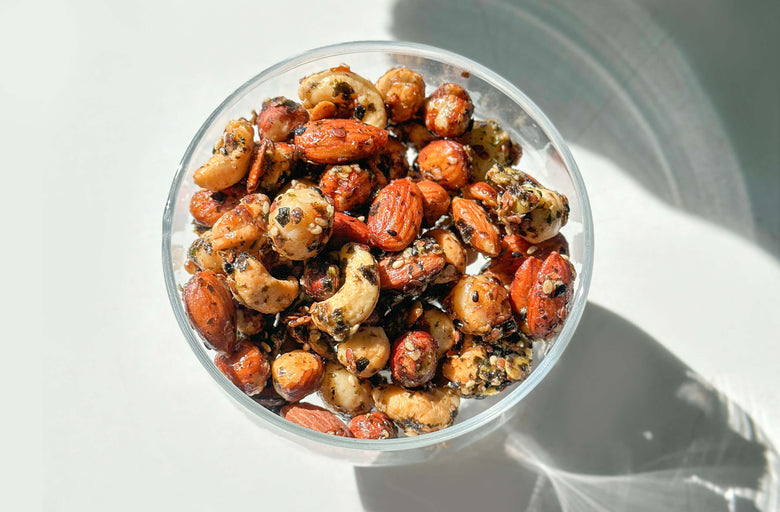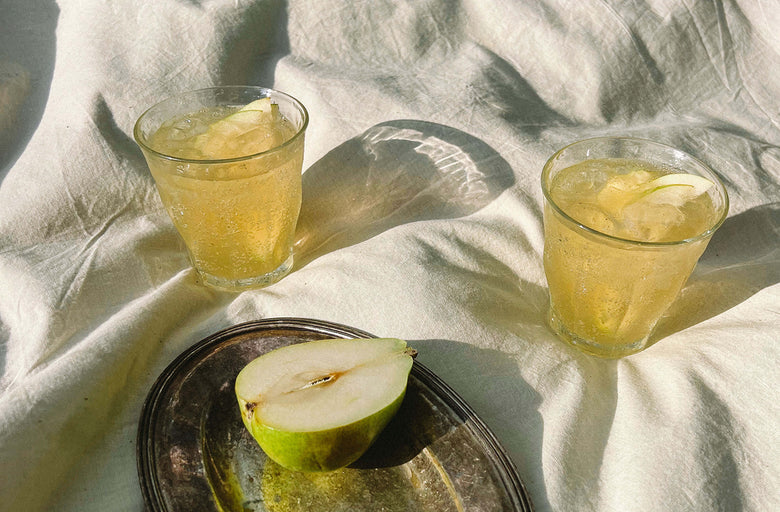I’ll admit it: I’m highly skeptical of things that claim to do it all. I’ve had trouble with moisturizers for both the face and the body, scrubs for the scalp and skin, two-in-one shampoos and conditioners, and don’t even get me started on “one-size-fits-most” clothes.
So believe me when I say that I was shocked to have found that my holy grail product was just that, a do-it-all, and even more so that it was hidden in my kitchen, just behind the olive oil. The name of my beloved? Apple cider vinegar.
You could say that I feel the same way about apple cider vinegar as the father in My Big Fat Greek Wedding felt about Windex. Skin looking a little congested? Put some apple cider vinegar on it. Dandruff? ACV, baby. Making a salad dressing? You guessed it. Over the past few years, I’ve unconsciously swapped out my skin, hair, and even cleaning products for this one, humble bottle––and the results have proven that a simple, natural ingredient can replace nearly all of the products in your cabinet.
I’m hardly the first to fall in love with a vinegar. From the Greeks to the Romans, Aryans to Phoenicians, vinegar was a major part of their culture. Soured apple wine was passed around the table, allowing for apple cider vinegar to develop as a by-product. Hippocrates was reported to have used vinegar to treat his patients, recommending it as a natural treatment to clean wounds, and it’s been said that Cleopatra used it as a facial cleanser. From the kitchen to the vanity, ACV serves a myriad of purposes and has withstood the test of time.
Apple cider vinegar is made from the process of fermenting apple cider, during which it turns into alcohol, and then into acetic acid thanks to the growth of bacteria. Natural, organic apple cider vinegars (the ones you should choose) have a cloudy look to them, due to the presence of “The Mother,” which is a dramatic way of referring to the beneficial bacteria grouping together at the bottom of the jar. It’s that same bacteria that turns apple cider into vinegar to begin with, not dissimilar to the strands sometimes seen floating in a bottle of kombucha. So if your bottle of ACV looks a little murky, don’t worry––the cloudiness is full of protein, B vitamins, enzymes, and probiotics. In fact, it is this bacteria alongside the acetic acid that are responsible for apple cider vinegar’s benefits, which, when consumed regularly, include improved digestion, increased immunity, and stabilized blood sugar levels.
I love ACV because of how easily it fits into my daily self-care routine––and actually provides results. I use it as an exfoliator, a scalp treatment, a cold remedy, and as the main ingredient in my go-to salad dressing. It’s convinced me once and for all that you really can do more with less.
It’s convinced me once and for all that you really can do more with less.
ACV SCALP TREATMENT
During an embarrassing bout of dandruff a few years ago for which I found myself apologizing to my hairstylist, I learned a helpful tip: scalp itching and flakiness can be caused by an unhealthy pH level. What alkalizes pH? Apple cider vinegar. My hairstylist recommended an ACV scalp treatment to help maintain a slightly acidic pH level of 4.5 to 5.5. It did away with the flakes, and I’ve relied on it regularly ever since.
Ingredients:
- 1-3 tablespoons apple cider vinegar
- 1/2 cup warm water
Directions:
Dilute apple cider vinegar into warm water. Massage into your scalp in the shower, right after shampooing but prior to conditioning. This allows the vinegar to permeate into your scalp without making you smell like a salad.
Spray Alternative: Use equal parts ACV and water in a spray bottle and apply to the scalp before shampooing. Massage it into your scalp and let it sit for five minutes before rinsing out.
ACV FACE MASK (Particularly beneficial for dry skin)
If you use a chemical exfoliant as part of your skin-care routine, chances are that you’re familiar with alpha-hydroxy acid (AHA), a group of acids that are touted for their ability to do everything from prevent breakouts to promote collagen production. ACV contains malic acid, an AHA found in apples that helps to slough away dead skin cells and promote the production of new ones. It is also known for its ability to go below the surface, increasing the production of not only collagen but also hyaluronic acid, which helps keep skin plump and hydrated.
Ingredients:
- 1 tbsp raw honey
- 2 tbsp apple cider vinegar
Directions:
Mix ingredients together and apply to clean, dry skin. Leave on for at least five minutes, no more than 10. Rinse off and follow with your moisturizer.
Scrub Alternative: Add a few teaspoons Himalayan pink salt to the mix to use as a natural facial exfoliator
LEMON APPLE GINGER COLD TONIC
Feeling stuffed up? Create a warm, soothing tonic that helps loosen mucus and alleviate cold symptoms so that your body can recover more quickly. Not only does this remedy help thin mucus when you’re sick, but the apple cider vinegar may even help create an alkaline environment in your body, which makes it difficult for germs to survive.
Ingredients:
- 1 tablespoon raw honey
- 1 teaspoon fresh ginger, chopped
- 1 tablespoon apple cider vinegar
- Cayenne pepper or red pepper flakes, to taste (at least 1/4 teaspoon per serving)
- Half a lemon, juiced
- Hot water
Directions:
Put on a pot of water to boil. While the water heats up, chop up fresh ginger and add to the base of a mug. Add raw honey, apple cider vinegar, lemon juice, and cayenne pepper to the cup. When water is ready, pour over the mixture and stir. Wait until it's cool enough to drink, but still warm, before consuming.
ALKALIZING ACV SALAD DRESSING
My mother has been making the same salad dressing my entire life. It takes all of five minutes, and works on everything from baby kale to romaine, arugula to apples. It’s fresh but zesty, transcends seasons, and best of all, is ridiculously simple and easily modified.
Ingredients:
- 1 1/2 parts apple cider vinegar
- 1 part extra virgin olive oil
- 1 teaspoon of Dijon mustard
- Raw honey to taste, or maple syrup if you prefer
- Salt and pepper to taste
- 1 clove fresh garlic (optional)
Directions:
Whisk ingredients together in a bowl until they emulsify. (If using raw garlic, add ingredients to a blender so that they puree.) Play with the ratios of ingredients until you have your own go-to blend (mine has a bit more honey than my mother’s, and almost always contains garlic).
More Homemade Healthy Remedies






